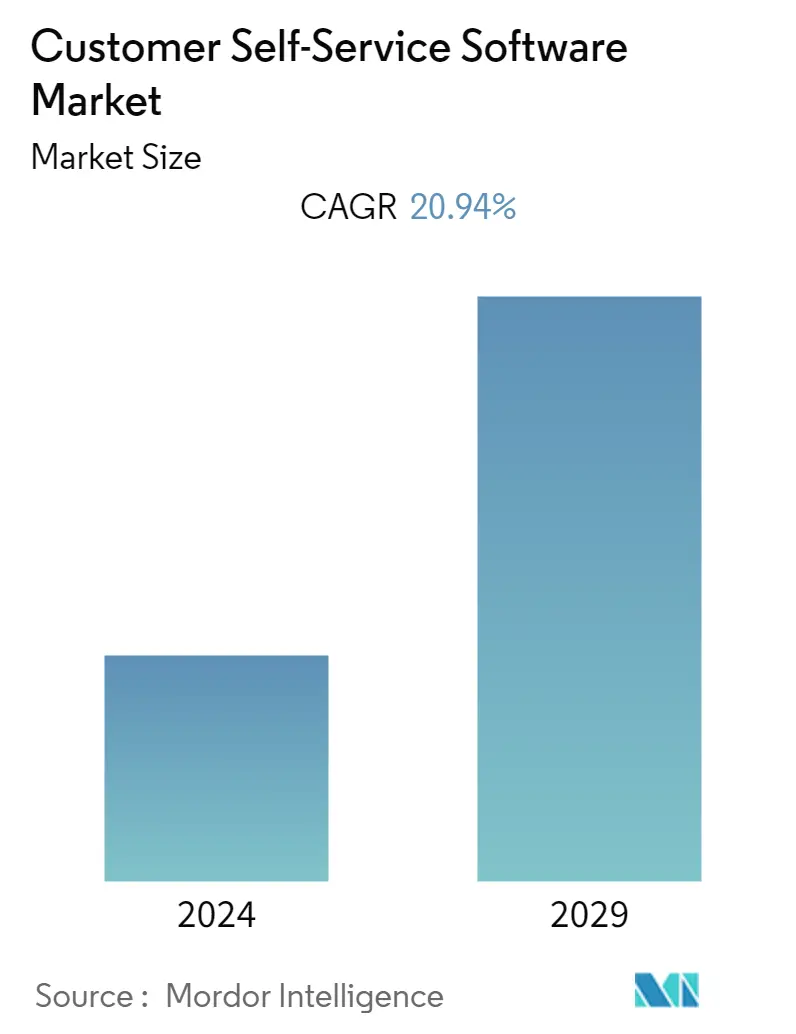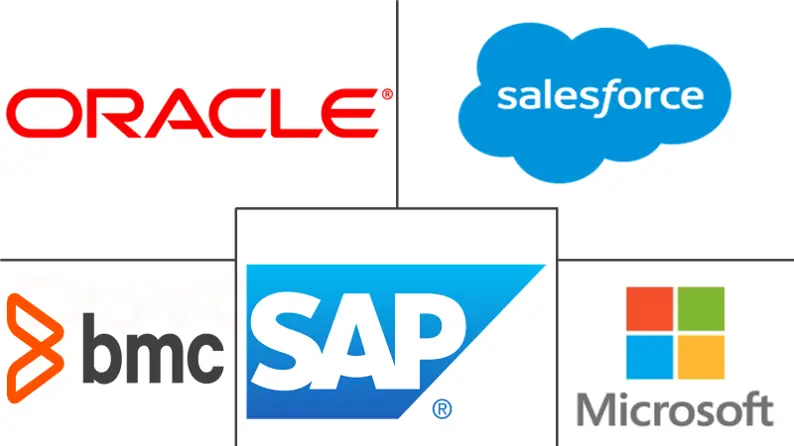Market Size of Customer Self-Service Software Industry

| Study Period | 2019 - 2029 |
| Base Year For Estimation | 2023 |
| CAGR | 20.94 % |
| Fastest Growing Market | Asia Pacific |
| Largest Market | North America |
| Market Concentration | Low |
Major Players
*Disclaimer: Major Players sorted in no particular order |
Customer Self-Service Software Market Analysis
The customer self-service software market is poised to register a CAGR of 20.94% during the forecast period. Organizations are increasingly implementing customer self-service software to expand their customer base and provide 24/7 help. Customer self-service software solutions allow businesses to respond efficiently to the ever-changing needs of their clients, increasing customer happiness and aiding in client retention. Customer self-service software can assist organizations in managing employee relationships and customer connections. As a result, businesses may be able to save the expenditures associated with purchasing separate software for managing employee and customer interactions. These are a few crucial elements anticipated to fuel market expansion for the foreseeable future.
- An increasing number of organizations now understand the benefits of reliable and dedicated self-service portals for enhancing the company's overall brand image. Self-service portals provide customers instant access to information, allow personalization, and save valuable time and organizational resources. According to SuperOffice, 70% of customers now expect a company's website to include a self-service application. The customized knowledge-based self-service portal plays a significant role in bringing in more website traffic. According to Salesforce, 39% of millennials check a company's FAQ when they have a question, showing a strong preference for finding answers.
- Some of the significant features of customer self-service software are it provides information to users without human interaction, assists end-users in completing familiar tasks, and provides continuous support to end-users seeking assistance. Most of the company helpdesks fail to deliver the required expectations, either due to being short-staffed or a lack of knowledge to answer a question immediately. Hence companies adopt these self-services, which help users find solutions themselves, often through a knowledge base or automated task management platform.
- The adoption of digital assistants is one of the significant trends emerging in the market. In the Retail and BFSI industry, chatbots have become a primary self-service feature. The companies utilize digital virtual assistants to enhance the customer experience. More companies are implementing AI- and ML-enabled chatbots and virtual assistants to leverage vital competitive advantages and improvise customer experiences. Further, chatbot technology is gaining much interest, with several companies investing significantly in Customer Relationship Management (CRM).
- However, it is projected that a potential lack of customer awareness and employee reluctance to implement self-service software will somewhat constrain market growth.
- The COVID-19 pandemic-related economic downturn led to a strategic shift in the purchasing criteria used by businesses, as they began putting business stability ahead of investing in new products and services. Before investing in self-service solutions, most companies think twice since any potential security holes in their third-party service providers' servers and information systems can jeopardize their clients' privacy. However, in the post-COVID-19 market scenario, owing to the benefits associated with customer self-service software, the demand for the software will increase throughout the forecast period.
Customer Self-Service Software Industry Segmentation
Customer self-service (CSS) software enables users to secure answers to their inquiries, through an automated interview, instead of traditional search approaches. The software also allows companies to address customer support needs in an on-demand fashion. Self-service solutions have evolved into a user-centric platform approach, which enables an anywhere-anytime access model with data integration from multiple sources supported through an open architecture. The scope of the market studied covers the solutions and services offered by various vendors in the market.
The Customer Self-service Software Market is segmented by Deployment (On-premise and Cloud), Offering (Solution and Service), End-User Industry (BFSI, Healthcare, Retail, Government, IT and Telecommunication), and Geography (North America, Europe, Asia-Pacific, Latin America, Middle East & Africa). The market sizes and forecasts are provided in terms of value (USD million) for all the above segments.
| By Deployment | |
| Cloud | |
| On-premise |
| By Offering | ||||
| ||||
| Service |
| By End-User Industry | |
| BFSI | |
| Healthcare | |
| Retail | |
| Government | |
| IT and Telecommunication | |
| Other End-user Industries |
| Geography | |
| North America | |
| Europe | |
| Asia-Pacific | |
| Latin America | |
| Middle East & Africa |
Customer Self-Service Software Market Size Summary
The customer self-service software market is experiencing significant growth, driven by the increasing adoption of digital solutions that enhance customer engagement and streamline operations. Businesses are leveraging these software solutions to provide round-the-clock support, improve customer satisfaction, and retain clients by efficiently addressing their evolving needs. The integration of self-service portals allows companies to offer personalized experiences and instant access to information, which not only enhances brand image but also optimizes resource allocation. The trend towards digital assistants, particularly in the Retail and BFSI sectors, is further propelling market expansion as companies invest in AI- and ML-enabled chatbots to gain competitive advantages and improve customer interactions. Despite potential challenges such as customer awareness and employee reluctance, the demand for self-service software is expected to rise, particularly in the post-COVID-19 landscape, where businesses prioritize cost-effective and efficient solutions.
The retail sector has been a prominent adopter of customer self-service solutions, with self-service checkouts and product-scanning technologies becoming increasingly common. Companies like Zappix are offering cloud-based digital self-service solutions that integrate with various back-end systems to enhance customer experiences and reduce operational costs. The market is characterized by a fragmented landscape with numerous players, including Oracle Corporation, Salesforce.Com Inc., and Microsoft Corporation, offering diverse solutions to meet consumer needs. Partnerships and technological advancements, such as those between ThoughtSpot and dbt Labs, are further driving the market by enabling self-service analytics and insights. North America leads the market due to high social media penetration, a strong presence of self-service vendors, and widespread cloud-based deployments, with companies in various sectors, including retail and banking, increasingly adopting self-service technologies to improve efficiency and customer satisfaction.
Customer Self-Service Software Market Size - Table of Contents
-
1. MARKET INSIGHTS
-
1.1 Market Overview
-
1.2 Industry Value Chain Analysis
-
1.3 Industry Attractiveness - Porter's Five Forces Analysis
-
1.3.1 Bargaining Power of Suppliers
-
1.3.2 Bargaining Power of Consumers
-
1.3.3 Threat of New Entrants
-
1.3.4 Threat of Substitute Products
-
1.3.5 Intensity of Competitive Rivalry
-
-
1.4 Assessment of the COVID-19 Impact on the Industry
-
-
2. MARKET SEGMENTATION
-
2.1 By Deployment
-
2.1.1 Cloud
-
2.1.2 On-premise
-
-
2.2 By Offering
-
2.2.1 Solution
-
2.2.1.1 Web-based
-
2.2.1.2 Mobile-based
-
-
2.2.2 Service
-
-
2.3 By End-User Industry
-
2.3.1 BFSI
-
2.3.2 Healthcare
-
2.3.3 Retail
-
2.3.4 Government
-
2.3.5 IT and Telecommunication
-
2.3.6 Other End-user Industries
-
-
2.4 Geography
-
2.4.1 North America
-
2.4.2 Europe
-
2.4.3 Asia-Pacific
-
2.4.4 Latin America
-
2.4.5 Middle East & Africa
-
-
Customer Self-Service Software Market Size FAQs
What is the current Customer Self-Service Software Market size?
The Customer Self-Service Software Market is projected to register a CAGR of 20.94% during the forecast period (2024-2029)
Who are the key players in Customer Self-Service Software Market?
Oracle Corporation, Salesforce.Com Inc., SAP SE, BMC Software Inc. and Microsoft Corporation are the major companies operating in the Customer Self-Service Software Market.

